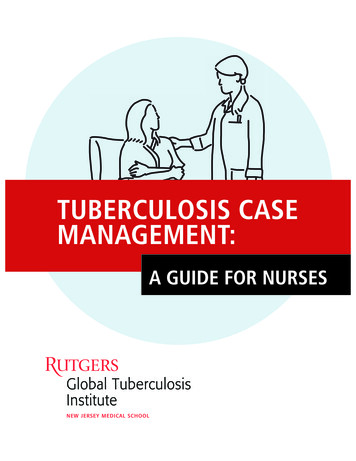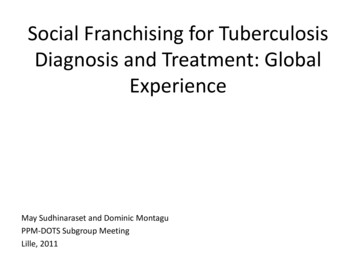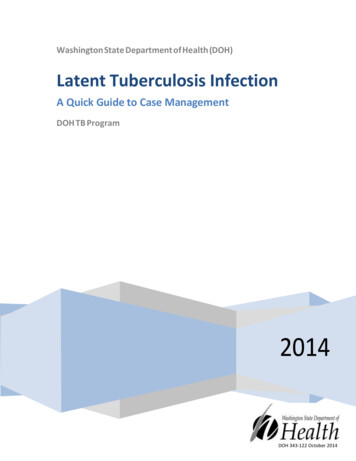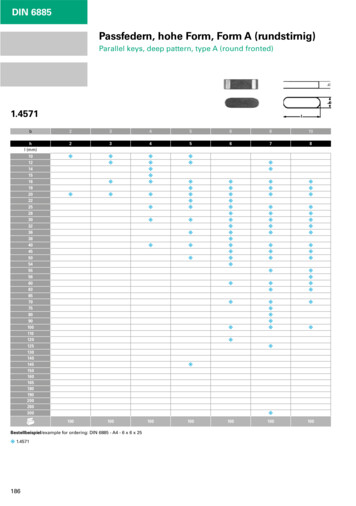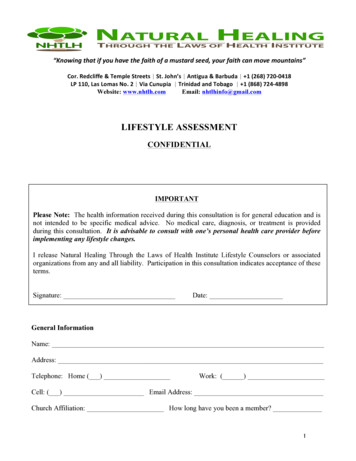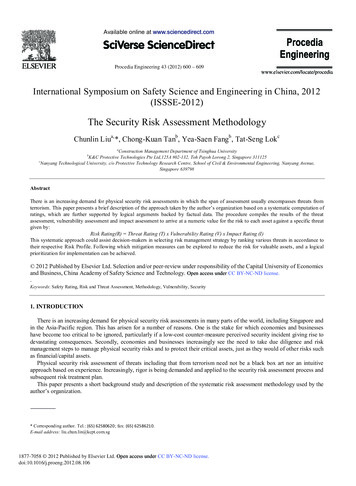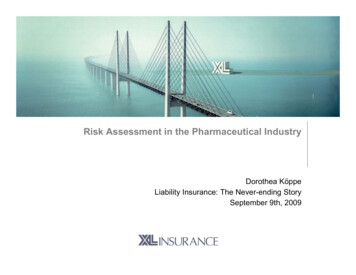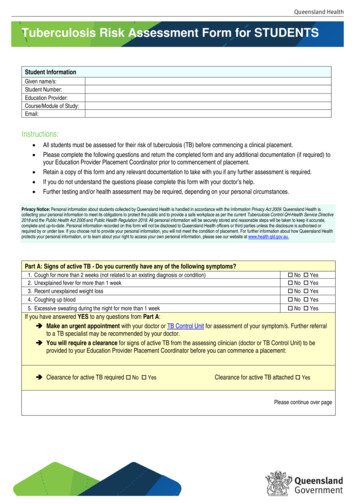
Transcription
Tuberculosis Risk Assessment Form for STUDENTSStudent InformationGiven name/s:Student Number:Education Provider:Course/Module of Study:Email:Instructions: All students must be assessed for their risk of tuberculosis (TB) before commencing a clinical placement.Please complete the following questions and return the completed form and any additional documentation (if required) toyour Education Provider Placement Coordinator prior to commencement of placement.Retain a copy of this form and any relevant documentation to take with you if any further assessment is required.If you do not understand the questions please complete this form with your doctor’s help.Further testing and/or health assessment may be required, depending on your personal circumstances.Privacy Notice: Personal information about students collected by Queensland Health is handled in accordance with the Information Privacy Act 2009. Queensland Health iscollecting your personal information to meet its obligations to protect the public and to provide a safe workplace as per the current Tuberculosis Control QH-Health Service Directive2018 and the Public Health Act 2005 and Public Health Regulation 2018. All personal information will be securely stored and reasonable steps will be taken to keep it accurate,complete and up-to-date. Personal information recorded on this form will not be disclosed to Queensland Health officers or third parties unless the disclosure is authorised orrequired by or under law. If you choose not to provide your personal information, you will not meet the condition of placement. For further information about how Queensland Healthprotects your personal information, or to learn about your right to access your own personal information, please see our website at www.health.qld.gov.au.Part A: Signs of active TB - Do you currently have any of the following symptoms?1.2.3.4.5.Cough for more than 2 weeks (not related to an existing diagnosis or condition)Unexplained fever for more than 1 weekRecent unexplained weight lossCoughing up bloodExcessive sweating during the night for more than 1 week No No No No No Yes Yes Yes Yes YesIf you have answered YES to any questions from Part A: Make an urgent appointment with your doctor or TB Control Unit for assessment of your symptom/s. Further referralto a TB specialist may be recommended by your doctor. You will require a clearance for signs of active TB from the assessing clinician (doctor or TB Control Unit) to beprovided to your Education Provider Placement Coordinator before you can commence a placement: Clearance for active TB required No YesClearance for active TB attached YesPlease continue over page
Part B: TB exposure risk history1. Were you born in Australia?If no, in what country were you born?2. Other than Australia or your country of birth, have you spent three (3) months or more in total within the pastfive (5) years visiting or living in any other country/ies? (For example, two months in country A and one monthin country B is three months in total).If yes, which countries? No Yes No Yes Check the TB country incidence list es/high-incidence-countries.aspx) foreach country you have listed in questions 1 and 2 and complete the following questions:3. Were you born, and/or have you spent three (3) months or more in total within the past five (5) years visiting No Yesor living in country/ies with a TB burden greater than 40 cases per 100 000 population (see link above)?4. Have you been in direct contact with a person with active TB disease, without using appropriate infectioncontrol precautions, within the past 2 years and you were not assessed for exposure to TB by hospital or No Yespublic health authorities (Contact may be work or non-work related).5. Have you previously worked ( 3 months) in any of the following settings: respiratory units; infectious diseaseunits or other medical units caring for infectious TB patients; clinical procedure units conducting bronchoscopy No Yesand/or sputum induction; TB laboratories; mortuaries?6. Have you ever been diagnosed with active TB (i.e. not latent TB)? No YesIf yes, in what year did you completetreatment?7. Do you have any underlying health issues or take any medications which may cause immunosuppression ? No YesIf you have answered YES to any of questions 3 – 5 from Part B, you require a test for latent TB infection: an Interferon Gamma Release Assay (IGRA) blood test can be ordered by your doctor – pathology fees may apply (a positiveor indeterminate IGRA result requires further consultation at a TB Control Unit or with your doctor. Your doctor may refer you toa TB specialist.OR a Tuberculin Skin Test (TST/Mantoux test) can be performed by referral to a TB Control Unit – at no cost to the patient, butrequires a follow-up appointment 2 or 3 days later.If testing for latent TB infection is required (and you have answered NO to all questions in Part A), you will still be able to commenceplacement. However, you must undertake further assessment with a doctor or at a TB Control Unit.If you have answered YES to any of questions 6 – 7 from Part B, you require further assessment. Contact your TB Control Unit foradvice.NOTE there is no out-of-pocket expense for treatment of TB in public health facilities in QueenslandPart C: Previous TB risk assessment procedures: – In the time since encountering the risk factors in Part B haveyou undergone any assessments or screening as below. If you have previously had a test for latent TB, to avoidunnecessary repetition of testing please take (if available) any supporting documents and additional information asindicated below to your doctor or TB Control Unit.Previous employment or immigration screening for TB? No YesPrevious TB risk assessment is on SPA (Staff Protect Application-Queensland Health Data Base) No YesPrevious pathology result (Quantiferon test or T-spot test) No YesPrevious printed result of a tuberculin skin test result (also called Mantoux test) No YesPage 2 of 6
Assessment Summary: Please tick the appropriate TB Risk Assessment Outcomes.If YES to any questions in Part A clearance for active TB isrequired prior to placement .Clearance for active TB attached to Risk Assessment form andreturned to your Education Provider Placement Coordinator .If NO to all questions in Part A AND NO to Part B questions 3to 7 (inclusive)-Nil further assessment required .Completed and signed Risk Assessment form returned to yourEducation Provider Placement Coordinator .If YES to any of questions Part B questions 3 – 7 furthertesting/consultation with a doctor or consultation at a TBControl Unit is required .Completed and signed Risk Assessment form returned to yourEducation Provider Placement Coordinator .Student consents to undertake assessment with a doctor or at a TBControl Unit .TB Control Units Contact Details sAcknowledgement and Consent:I certify that I have read and understand the Queensland Health: Protocol for the control of tuberculosis— section 3.3.18Workers and students in health care facilities risk assessment on the Queensland Health Clinical Placement website, inpreparation for my placement. I agree to comply with the guidelines and all procedures in place at the QueenslandHospital and Health Service facility at which I am placed, in respect of Queensland Health vaccination andinfection control of health care workers.I understand that this risk assessment and any required follow-up action is one of the requirements of eligibilityfor a placement at a Queensland Hospital and Health Service facility, and I agree to take action as required.I consent to my education provider giving personal information in this form to Queensland Health (including theDepartment of Health and Hospital and Health Services) for placement and infection management planning andresponse. This may include infection control units and TB control units.I certify that the information I have provided in this risk assessment is true and correct.Full Name:Signed:Date:Further information and Resources-Tuberculosis Risk Assessment- Frequently Asked Questions (FAQ) for Workers in Queensland Health FacilitiesTuberculosis Risk Assessment-Guideline for Education Provider Placement Co-ordinatorsPage 3 of 6
Clinician Use OnlyAssessment of Tertiary Students for active and latent tuberculosis: Helpful Hints for General Practitioners.While tuberculosis (TB) is not common in Australia, each year 1200-1300 cases of TB are diagnosed nationally, of which almost 10%are tertiary students and almost 5% are past or current healthcare workers (HCW). The majority of such cases, but not all, are bornoverseas in countries with much higher rates of TB than we have in Australia.Queensland Health requires all students who are to undertake placement in a clinical setting to complete a TB risk assessmentquestionnaire to help identify active TB and latent TB. Those who are identified as being at risk, may present to their GP for furtherassessment.There are three main scenarios to consider.A. Student self-reports symptoms which could be active TBThe symptoms as described on the risk assessment which may prompt a referral for assessment are one or more of the following:1.2.3.4.5.Cough for more than 2 weeks (not related to an existing diagnosis or condition)Unexplained fever for more than 1 weekRecent unexplained weight lossCoughing up bloodExcessive sweating at night for more than one week.As prolonged cough and haemoptysis may be features of pulmonary TB, it is recommended that such symptoms be identified at thetime of booking-in the patient (if possible), in order that appropriate infection control precautions may be implemented, such as thepatient waiting outside until called and the patient wearing a surgical mask when inside the practice (this reduces production ofinfectious aerosols should the patient actually have TB).You may prefer to promptly refer your patient to a public TB Control Unit (TBCU) (contact details below) where no further out of pocketexpenses will be incurred for the student. Similarly, a referral to a specialist experienced in TB medicine (usually a respiratoryphysician or infectious diseases physician) may be considered.Investigations which may be initiated from primary care, if undertaken, should include:-Three expectorated sputum for “AFBs” (acid fast bacilli) – note sputa should be collected external to a GP practice orpathology collection office (away from others) unless appropriate negative pressure facilities are available.A CXR (PA and lateral views).If the CXR is abnormal or sputa are smear or culture positive for TB, referral to a TBCU or a specialist experienced in TB medicine isrecommended.B. Student is asymptomatic but has risk factors that make latent TB more likelyIn most cases, it is being born in a country with high TB incidence which makes TB infection more likely, but living in such countries fora prolonged period and working in clinical or laboratory areas with increased potential exposure to TB are also risk factors.People with latent TB are asymptomatic but they may progress to active TB including infectious pulmonary TB with a lifetime risk of 10%. This risk can be reduced by 80 – 90% by administering antimicrobial therapy for 4 – 9 months (depending on the agent used).Students with increased risk for latent TB are asked to present to a TBCU or GP for further testing.Latent TB can only be diagnosed by a test which measures immune response to TB proteins; either an interferon-gamma releaseassay (IGRA) or a tuberculin skin test.The most practical test in general practice is the QuantiFERON Gold Plus test (IGRA) as it requires a single blood sample, is done bypublic and private labs and is unaffected by previous BCG vaccination.Page 4 of 6
A negative IGRA test needs no further action in an asymptomatic student (NOTE: an IGRA test should not be used to exclude activeTB as it may be falsely negative).A student with a positive IGRA test should be counselled regarding the pros and cons of preventative antimicrobial treatment. ActiveTB should be excluded before treatment for latent TB is commenced. At this point referral to a TBCU or experienced TB clinician canbe considered for expert assessment and choice of preventative regimen (usually rifampicin or isoniazid daily therapy). A CXR prior toreferral is helpful- if the CXR is abnormal request a priority review.As Medicare reimbursement for the IGRA is limited and considering that many overseas students may not be Medicare eligible, thereis often a charge for this test when ordered privately.A tuberculin skin test can be performed by a TBCU. It is free of charge, but requires 2 visits to the clinic 48 – 72 hours apart and maybe positive due to past BCG vaccination rather than true latent TB.C. Student is at increased risk of progression to active TB and more severe disease because they have a suppressedimmune systemThere are many reasons for immune suppressed states including HIV infection, organ transplant anti-rejection drugs, connective tissuediseases etc. Students are asked to identify whether they have an immune suppressing condition. If “yes” they should see their doctorregarding testing for latent TB. A negative test is a useful baseline and a positive test should prompt discussion and offering ofpreventative antimicrobial therapy.Additional information including contact details for Queensland TB Control Units can be found on the Queensland Health TuberculosisWebpage at isPage 5 of 6
Queensland HealthFigure 1 Flow chart for TB Risk Assessment ManagementStudent presents because of risks for active and/or latent TBSymptoms consistent with active TBImplement appropriate infectioncontrol precautions* CXR (PA/Lat) 3 sputa on 3 separate days for “AFBmicroscopy and culture”Asymptomatic but risks factors for latent TBRefer to TBCU forTST and furthermanagementORPOSITIVE orINDETERMINANTCXR normal, No AFBSon microscopy and noMycobacteria grownEither CXRabnormalityconsistent with TBOR AFBs onmicroscopy orMycobacteriagrownConsider CXR priorto referral. IF CXRabnormal, requestpriority reviewIGRA test(QuantiferonGold Plus) *NEGATIVEDischargeAssess as for latentTB if risk factorsRefer to QH TB Control Unit (TBCU) or Specialistexperienced in TB management* Infection control guidelines for the management of patients with suspected or confirmed pulmonary tuberculosis inhealthcare settings nsf/content/cda-cdi4003-pdf-cnt.htm*Medicare listing for reimbursement of IGRA tests:Test of cell mediated immune response in blood for the detection of latent tuberculosis by interferon gamma releaseassay (IGRA) in the following people:(a) a person who has been exposed to a confirmed case of active tuberculosis;(b) a person who is infected with human immunodeficiency virus;(c) a person who is to commence, or has commenced, tumour necrosis factor (TNF) inhibitor therapy;(d) a person who is to commence, or has commenced, renal dialysis;(e) a person with silicosis;(f) a person who is, or is about to become, immunosuppressed because of a disease, or a medical treatment, notmentioned in paragraphs (a) to (e).Page 6 of 6
B. Student is asymptomatic but has risk factors that make latent TB more likely In most cases, it is being born in a country with high TB incidence which makes TB infection more likely, but living in such countries for a prolonged period and working in clinical or laboratory areas with
